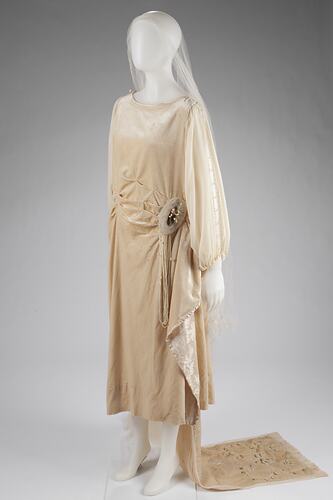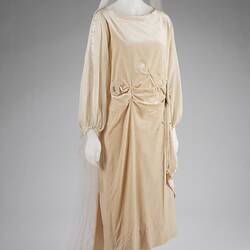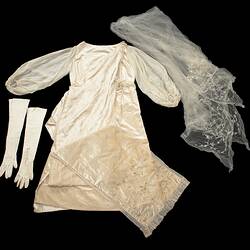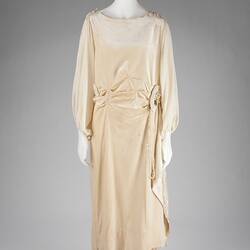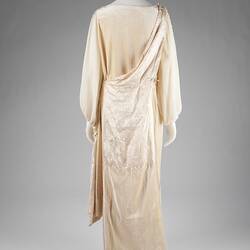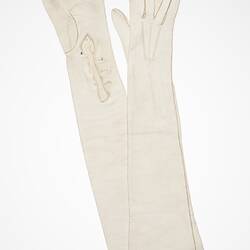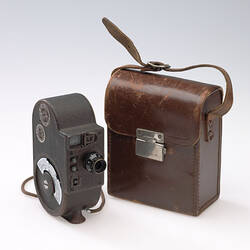Summary
Wedding dress, veil and gloves worn by Lili Vrahamis at her wedding to Letho Sigalas at the Greek Orthodox church in Victoria Parade, Melbourne in 1923. It was made by a Greek dressmaker in Melbourne. After the ceremony, a large dinner was given for the newlyweds at a café in Punt Road.
Lili (Eleni) Sigalas (nee Vrahamis), born in 1904, was the daughter of Callirrhoe Dressler and Stavros Vrahamis, both from the Greek Island of Sikinos, who also lived for some time in Istanbul. In 1920 Lili was engaged to a cousin Letho (Eleutherios) Sigalas, and in 1922 migrated to Melbourne on the 'Largs Bay' with her father-in-law to be, James (Iakovos) Sigalas, and her elder married sister Alex. Letho and Lili were married at the Greek Orthodox Church on Victoria Parade, on 18 July 1923, just eight days before Lili's 19th birthday. They had two daughters - Dan'e in 1924 and Magarita Babette in 1931.
Physical Description
Cream velvet dress with georgette sleeves, pearl brooch and hanging beads, waxed orange blossom. Fine netted veil and cream kid leather gloves with three pearl buttons on each glove.
Significance
The Sigalas family's immigration story is a rich narrative which relates to a number of themes in the history of social and immigration Melbourne. The wedding dress is an evocative symbol of a key immigration motivation for young women - being brought out to Australia to marry men from similar cultural backgrounds, islands and villages.
The Sigalas family story signifies migration as a continuous experience for some people: of shifting from country to country until finding the right spot to settle; of the strong ties to homelands which draws people back again and again; of chain migration; of finding brides in home countries in order to establish families in the new. While the objects do not directly pursue these themes, they can provide the point from which these complex migration themes can be explored.
More Information
-
Collecting Areas
Clothing & Textiles, Migration & Cultural Diversity, Public Life & Institutions
-
Acquisition Information
Donation from Babette Sigalas, Jul 2003
-
User
Mrs Lili Sigalas, Victoria Parade, East Melbourne, Greater Melbourne, Victoria, Australia, 18 Jul 1923
Worn by Lili at her wedding to Letho Sigalas -
Place & Date Made
-
Place & Date Used
Greek Orthodox Church, Victoria Parade, East Melbourne, Greater Melbourne, Victoria, Australia, 18 Jul 1923
-
Classification
-
Category
-
Discipline
-
Type of item
-
Keywords
Greek Communities, Greek Immigration, Immigration, Wedding Costumes, Weddings, Women's Clothing
